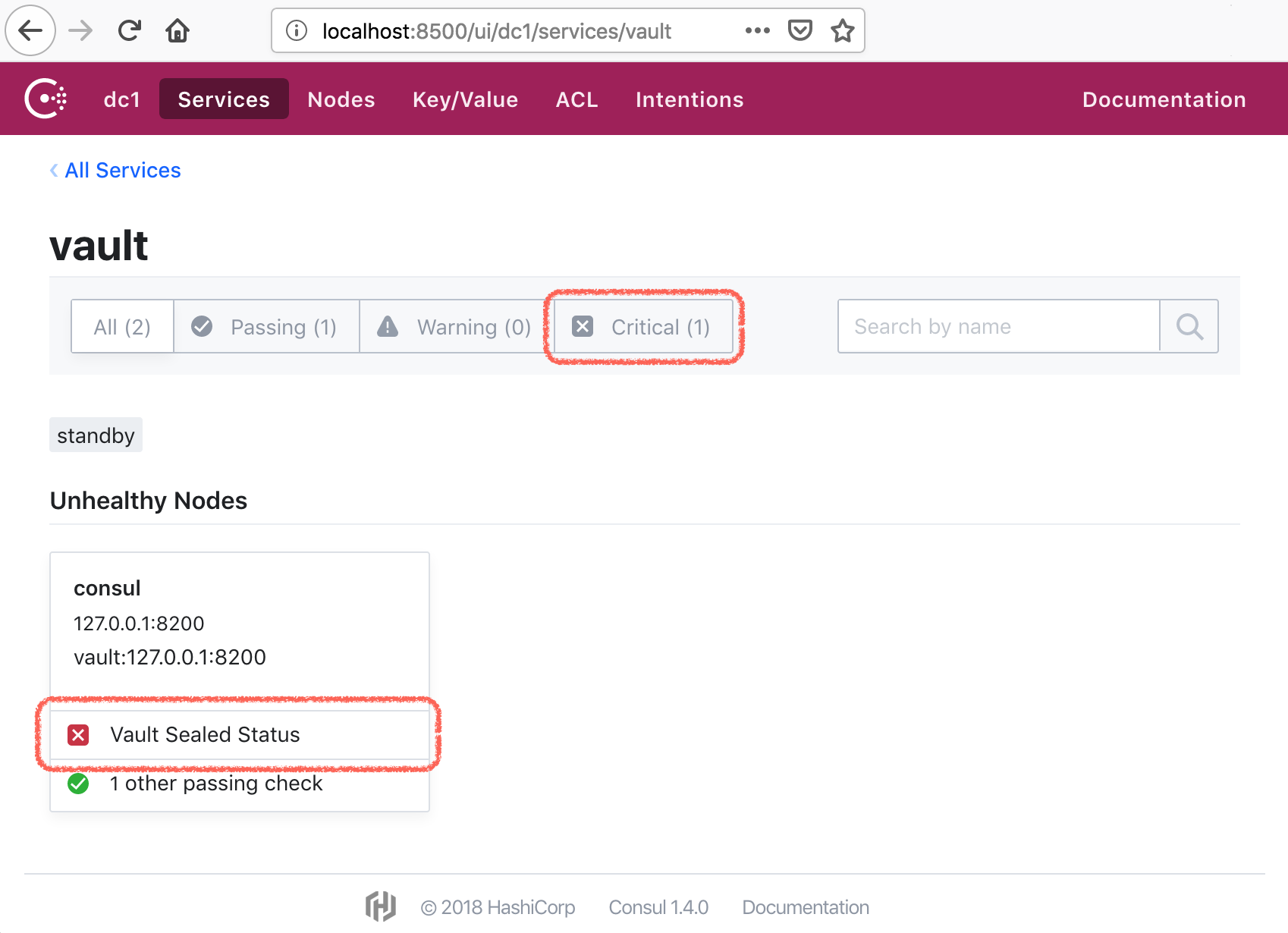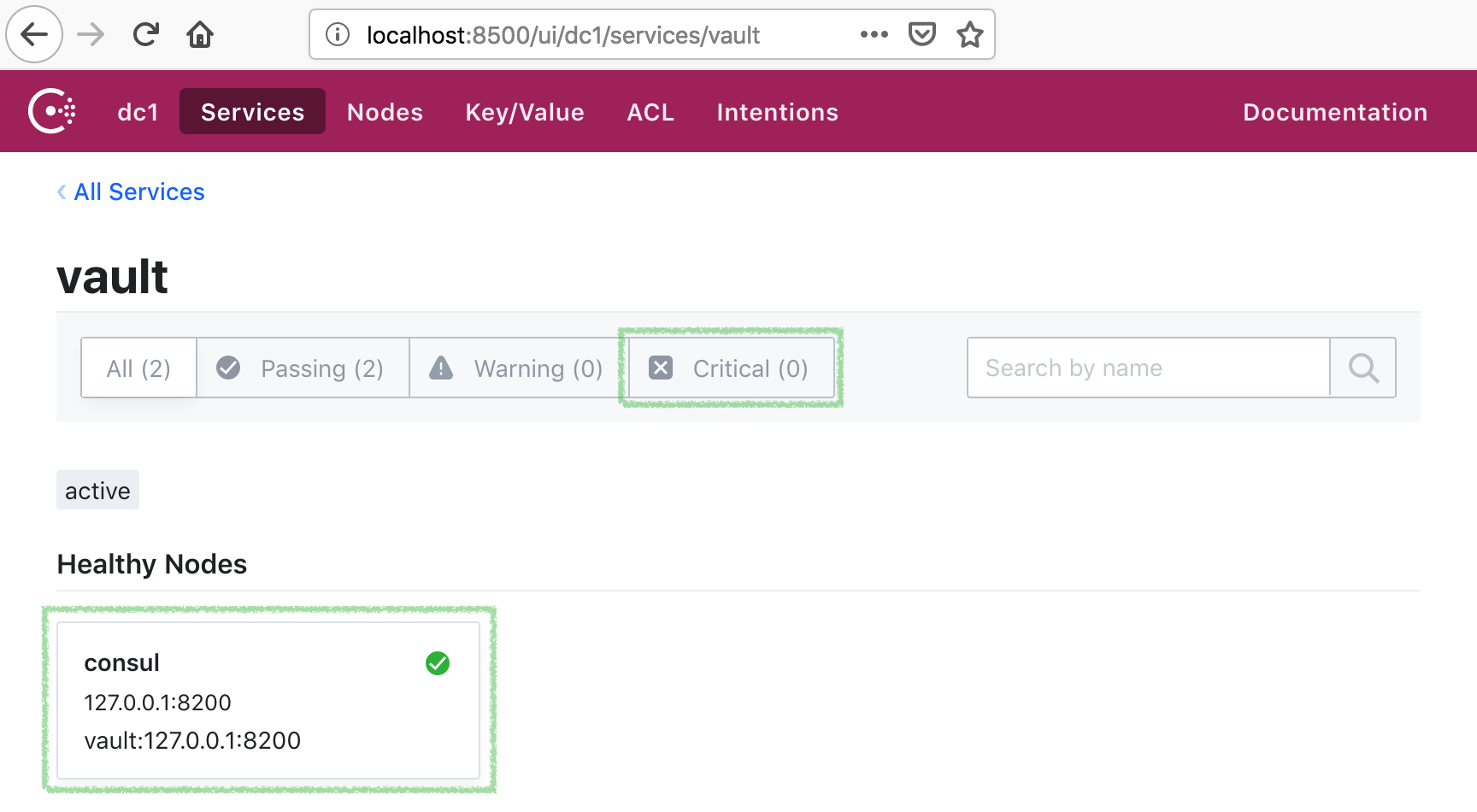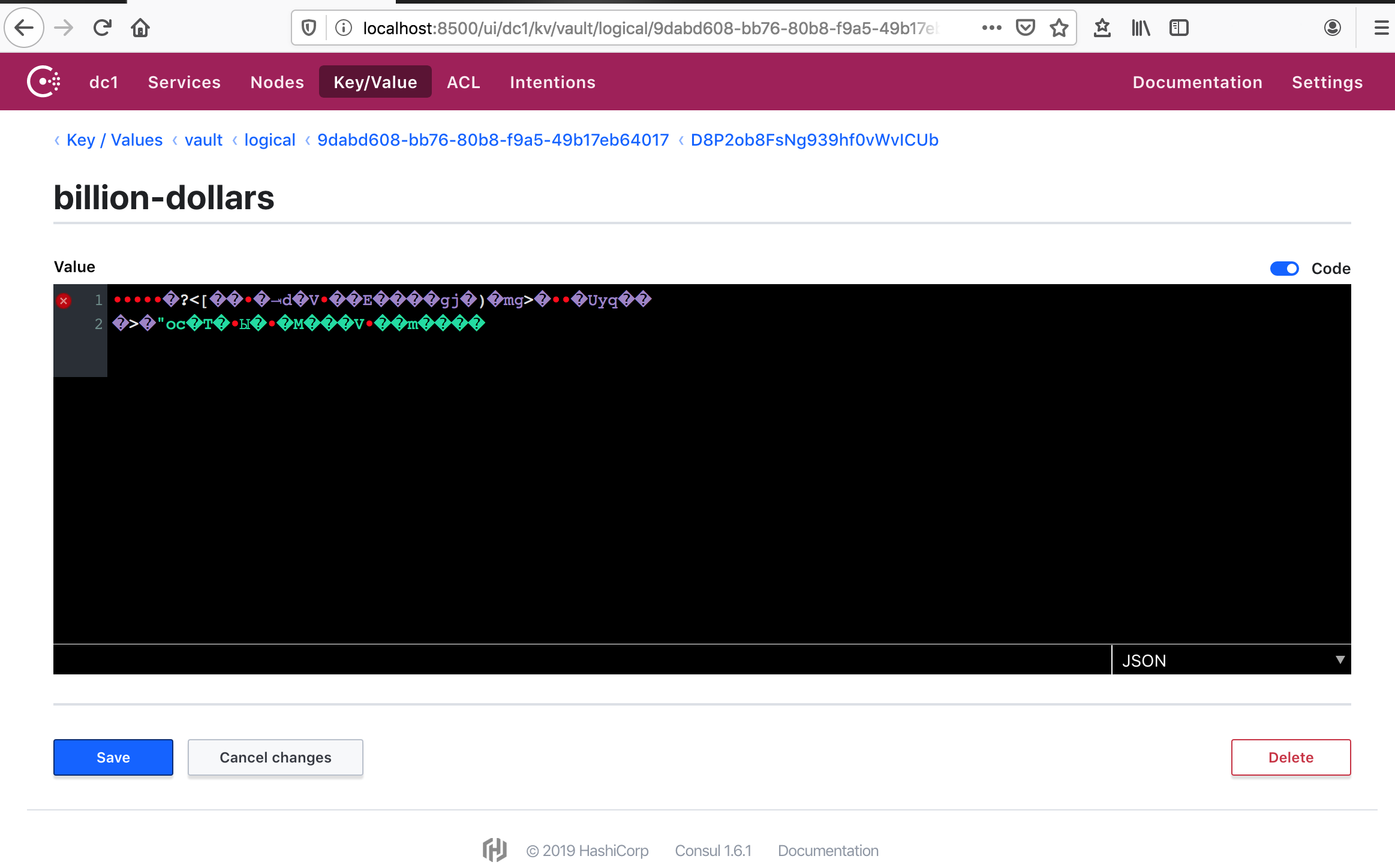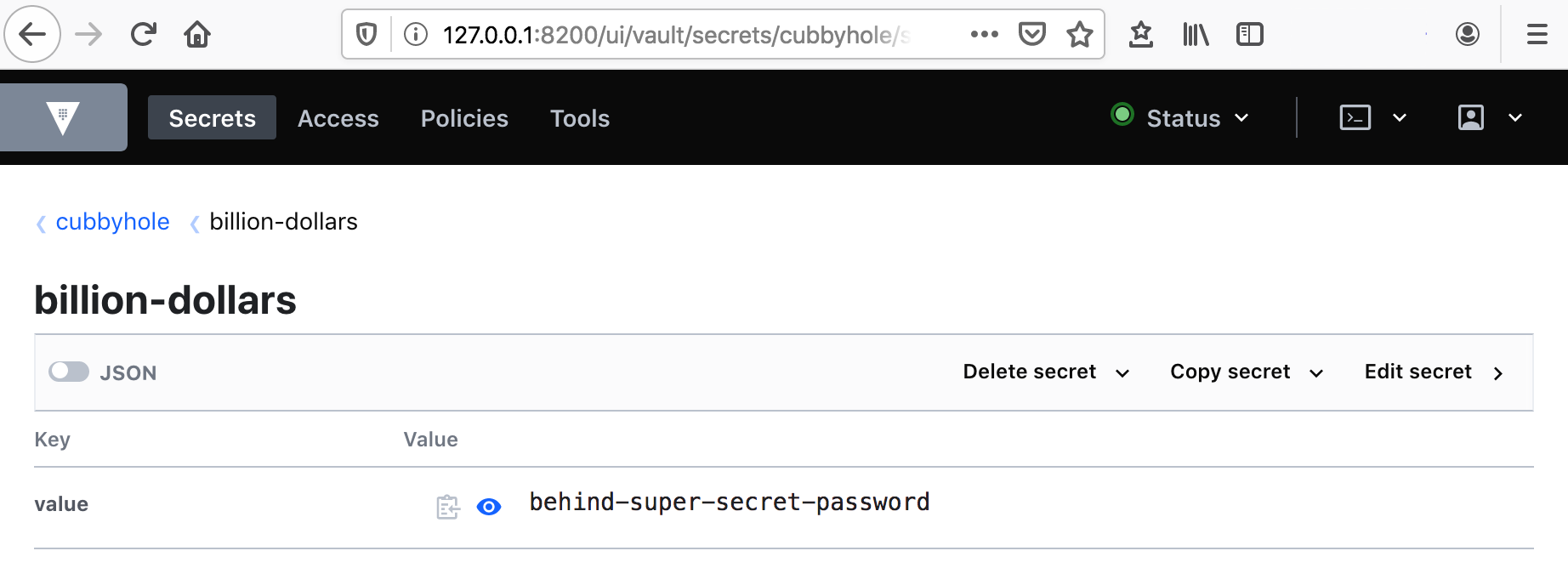tolitius / Cault
Programming Languages
Projects that are alternatives of or similar to Cault
cault
Consul and Vault are started together in two separate, but linked, docker containers.
Vault is configured to use a consul secret backend.
Start Consul and Vault
docker-compose up -d
Getting Vault Ready
Login to the Vault image:
docker exec -it cault_vault_1 sh
Check Vault's status:
$ vault status
Key Value
--- -----
Seal Type shamir
Initialized false
Sealed true
Total Shares 0
Threshold 0
Unseal Progress 0/0
Unseal Nonce n/a
Version n/a
HA Enabled true
Because Vault is not yet initialized (Initialized false), it is sealed (Sealed true), that's why Consul will show you a sealed critial status:
Init Vault
$ vault operator init
Unseal Key 1: dW2PXpPdjWZvXCUvE/GWxJ+CdeEp6SziEKh6xNYRpB8k
Unseal Key 2: 5K52IOOU+rZf+6Aj7PBOTclnL80Ftb1Wta1GbrJDWX8f
Unseal Key 3: ykK/Q5Il7OOp/qKTdT75U1q6EDzMo2LkM0KRWv7I11Lb
Unseal Key 4: /1EVEn1UDG4LbqI2h5MQPWRI1wpCbirELJyVBo+D2QR1
Unseal Key 5: H47Vch2d0AxuA43kxOlW+MzC/YtjoGU8wCoZLDmRg29r
Initial Root Token: s.1ee2zxWvX43sAwjlcDaSGGSC
Vault initialized with 5 key shares and a key threshold of 3. Please securely
distribute the key shares printed above. When the Vault is re-sealed,
restarted, or stopped, you must supply at least 3 of these keys to unseal it
before it can start servicing requests.
Vault does not store the generated master key. Without at least 3 key to
reconstruct the master key, Vault will remain permanently sealed!
It is possible to generate new unseal keys, provided you have a quorum of
existing unseal keys shares. See "vault operator rekey" for more information.
notice Vault says:
you must provide at least 3 of these keys to unseal it again
hence it needs to be unsealed 3 times with 3 different keys (out of the 5 above)
Unsealing Vault
$ vault operator unseal
Unseal Key (will be hidden):
Key Value
--- -----
...
Sealed true
Unseal Progress 1/3
$ vault operator unseal
Unseal Key (will be hidden):
Key Value
--- -----
...
Sealed true
Unseal Progress 2/3
$ vault operator unseal
Unseal Key (will be hidden):
Key Value
--- -----
...
Initialized true
Sealed false
...
Active Node Address <none>
the Vault is now unsealed:
Auth with Vault
We can use the Initial Root Token from above to auth with the Vault:
$ vault login
Token (will be hidden):
Success! You are now authenticated. The token information displayed below
is already stored in the token helper. You do NOT need to run "vault login"
again. Future Vault requests will automatically use this token.
Key Value
--- -----
token s.1ee2zxWvX43sAwjlcDaSGGSC
token_accessor shMBI822edbRUYTo8mW54mdB
token_duration ∞
token_renewable false
token_policies ["root"]
identity_policies []
policies ["root"]
All done: now you have both Consul and Vault running side by side.
Making sure it actually works
From the host environment (i.e. outside of the docker image):
alias vault='docker exec -it cault_vault_1 vault "[email protected]"'
This will allow to run vault commands without a need to login to the image.
the reason commands will work is because you just
auth'ed (logged into Vault) with a root token inside the image in the previous step.
Watch Consul logs
In one terminal tail Consul logs:
$ docker logs cault_consul_1 -f
Writing / Reading Secrets
In the other terminal run vault commands:
$ vault write -address=http://127.0.0.1:8200 cubbyhole/billion-dollars value=behind-super-secret-password
Success! Data written to: cubbyhole/billion-dollars
Check the Consul log, you should see something like:
2016/12/28 06:52:09 [DEBUG] http: Request PUT /v1/kv/vault/logical/a77e1d7f-a404-3439-29dc-34a34dfbfcd2/billion-dollars (199.657µs) from=172.28.0.3:50260
Let's read it back:
$ vault read cubbyhole/billion-dollars
Key Value
--- -----
value behind-super-secret-password
And it is in fact in Consul:
and in Vault:
(this is from Vault's own UI that is enabled in this image)
Response Wrapping
NOTE: for these examples to work you would need jq (i.e. to parse JSON responses from Vault).
brew install jqorapt-get install jqor similar
System backend
Running with a System Secret Backend.
Export Vault env vars for the local scripts to work:
$ export VAULT_ADDR=http://127.0.0.1:8200
$ export VAULT_TOKEN=s.1ee2zxWvX43sAwjlcDaSGGSC ### root token you remembered from initializing Vault
At the root of cault project there is creds.json file (you can create your own of course):
$ cat creds.json
{"username": "ceo",
"password": "behind-super-secret-password"}
We can write it to a "one time place" in Vault. This one time place will be accessible by a "one time token" Vault will return from a
/sys/wrapping/wrap endpoint:
$ token=`./tools/vault/wrap-token.sh creds.json`
$ echo $token
s.sMFwpg8DBYh0NXbXqjLJTNKN
You can checkout wrap-token.sh script, it uses /sys/wrapping/wrap Vault's endpoint
to secretly persist creds.json and return a token for it that will be valid for 60 seconds.
Now let's use this token to unwrap the secret:
$ ./tools/vault/unwrap-token.sh $token
{"password": "behind-super-secret-password",
"username": "ceo" }
You can checkout unwrap-token.sh script, it uses /sys/wrapping/unwrap Vault's endpoint
Let's try to use the same token again:
$ ./tools/vault/unwrap-token.sh $token
["wrapping token is not valid or does not exist"]
i.e. Vault takes one time pretty seriously.
Cubbyhole backend
Running with a Cubbyhole Secret Backend.
Export Vault env vars for the local scripts to work:
$ export VAULT_ADDR=http://127.0.0.1:8200
$ export VAULT_TOKEN=s.1ee2zxWvX43sAwjlcDaSGGSC ### root token you remembered from initializing Vault
Create a cubbyhole for the billion-dollars secret, and wrap it in a one time use token:
$ token=`./tools/vault/cubbyhole-wrap-token.sh /cubbyhole/billion-dollars`
let's look at it:
$ echo $token
s.T3GT2dGb8bUuJtSEenxnZick
looks like any other token, but it is in fact a one time use token, only for this cobbyhole.
Let's use it:
$ curl -s -H "X-Vault-Token: $token" -X GET $VAULT_ADDR/v1/cubbyhole/response
{
"request_id": "f0cf41a6-d971-69be-4eee-c7137376a755",
"lease_id": "",
"renewable": false,
"lease_duration": 0,
"data": {
"response": "{\"request_id\":\"083429a1-2956-39f0-a402-628b6e346ac0\",\"lease_id\":\"\",\"renewable\":false,\"lease_duration\":0,\"data\":{\"value\":\"behind-super-secret-password\"},\"wrap_info\":null,\"warnings\":null,\"auth\":null}"
},
"wrap_info": null,
"warnings": [
"Reading from 'cubbyhole/response' is deprecated. Please use sys/wrapping/unwrap to unwrap responses, as it provides additional security checks and other benefits."
],
"auth": null
}
(notice: that "cubbyhole/response" is deprecated, use the system backend instead. example is in the section above)
Let's try to use it again:
$ curl -s -H "X-Vault-Token: $token" -X GET $VAULT_ADDR/v1/cubbyhole/response
{"errors":["permission denied"]}
Vault takes one time pretty seriously.
Troubleshooting
Bad Image Caches
In case there are some stale / stopped cached images, you might get connection exceptions:
failed to check for initialization: Get v1/kv/vault/core/keyring: dial tcp i/o timeout
reconcile unable to talk with Consul backend: error=service registration failed: /v1/agent/service/register
you can purge stopped images to solve that:
docker rm $(docker ps -a -q)
License
Copyright © 2019 tolitius
Distributed under the Eclipse Public License either version 1.0 or (at your option) any later version.




